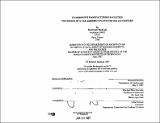Tomorrow's manufacturing facilities : the design of a car assembly plant for the 21st century
Author(s)
Medioni, Bertrand
DownloadFull printable version (3.651Mb)
Alternative title
Design of a car assembly plant for the 21st century
Other Contributors
Massachusetts Institute of Technology. Dept. of Architecture.
Advisor
Waclaw Piotr Zalewski.
Terms of use
Metadata
Show full item recordAbstract
Spatial reorganization of production conditions (resulting from technical progress in the field of fabrication), on both, a large and a small scale, implies that an important effort from industrial companies has been made to develop new concepts for the working environment. Many companies, such as IBM, Renault or Olivetti, have already invested large amount of money and research time in the definition of their future factories, involving architects, sociologists, economists, etc. As a consequence, new and different requirements have been formulated that have to be considered by architects and engineers in charge of the design. Flexibility, and a deep concern about protecting future design possibilities, in order to make the best adaptation to the market, lead these thoughts. Because a car assembly plant involves a wide range of different techniques, in the production area, and allows the definition of building and design criteria for the construction industry, it has been chosen as a case study. The present thesis analyzes the existing models and their problems, determines a direction for solutions, and explores a new structural modular system, as a step towards new approaches for design and construction. The design proposal shows an example of a displacesable building, with the same duration cycle as the manufactured product, and minimum damaging consequences for the site.
Description
Thesis (M.S.)--Massachusetts Institute of Technology, Dept. of Architecture, 1987. MICROFICHE COPY AVAILABLE IN ARCHIVES AND ROTCH. Includes bibliographical references (leaves 85-86).
Date issued
1987Department
Massachusetts Institute of Technology. Department of ArchitecturePublisher
Massachusetts Institute of Technology
Keywords
Architecture.